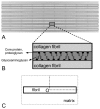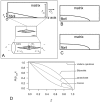Collagenous Extracellular Matrix Biomaterials for Tissue Engineering: Lessons from the Common Sea Urchin Tissue
- PMID: 28441344
- PMCID: PMC5454814
- DOI: 10.3390/ijms18050901
Collagenous Extracellular Matrix Biomaterials for Tissue Engineering: Lessons from the Common Sea Urchin Tissue
Abstract
Scaffolds for tissue engineering application may be made from a collagenous extracellular matrix (ECM) of connective tissues because the ECM can mimic the functions of the target tissue. The primary sources of collagenous ECM material are calf skin and bone. However, these sources are associated with the risk of having bovine spongiform encephalopathy or transmissible spongiform encephalopathy. Alternative sources for collagenous ECM materials may be derived from livestock, e.g., pigs, and from marine animals, e.g., sea urchins. Collagenous ECM of the sea urchin possesses structural features and mechanical properties that are similar to those of mammalian ones. However, even more intriguing is that some tissues such as the ligamentous catch apparatus can exhibit mutability, namely rapid reversible changes in the tissue mechanical properties. These tissues are known as mutable collagenous tissues (MCTs). The mutability of these tissues has been the subject of on-going investigations, covering the biochemistry, structural biology and mechanical properties of the collagenous components. Recent studies point to a nerve-control system for regulating the ECM macromolecules that are involved in the sliding action of collagen fibrils in the MCT. This review discusses the key attributes of the structure and function of the ECM of the sea urchin ligaments that are related to the fibril-fibril sliding action-the focus is on the respective components within the hierarchical architecture of the tissue. In this context, structure refers to size, shape and separation distance of the ECM components while function is associated with mechanical properties e.g., strength and stiffness. For simplicity, the components that address the different length scale from the largest to the smallest are as follows: collagen fibres, collagen fibrils, interfibrillar matrix and collagen molecules. Application of recent theories of stress transfer and fracture mechanisms in fibre reinforced composites to a wide variety of collagen reinforcing (non-mutable) connective tissue, has allowed us to draw general conclusions concerning the mechanical response of the MCT at specific mechanical states, namely the stiff and complaint states. The intent of this review is to provide the latest insights, as well as identify technical challenges and opportunities, that may be useful for developing methods for effective mechanical support when adapting decellularised connective tissues from the sea urchin for tissue engineering or for the design of a synthetic analogue.
Keywords: collagen fibril; decellularised tissue; elastic stress transfer; fibril diameter; fibril taper; fibril-fibril interactions; fracture; mutable collagenous tissues; plastic stress transfer.
Conflict of interest statement
The authors declare no conflict of interest.
Figures















Similar articles
-
Correlations between the biochemistry and mechanical states of a sea-urchin ligament: a mutable collagenous structure.Biointerphases. 2012 Dec;7(1-4):38. doi: 10.1007/s13758-012-0038-6. Epub 2012 Jun 15. Biointerphases. 2012. PMID: 22700358
-
Marine-derived collagen biomaterials from echinoderm connective tissues.Mar Environ Res. 2017 Jul;128:46-57. doi: 10.1016/j.marenvres.2016.03.007. Epub 2016 Mar 31. Mar Environ Res. 2017. PMID: 27063846
-
Collagen and proteoglycan in a sea urchin ligament with mutable mechanical properties.Cell Tissue Res. 1989 Dec;258(3):527-39. doi: 10.1007/BF00218864. Cell Tissue Res. 1989. PMID: 2611859
-
Hierarchical mechanics of connective tissues: integrating insights from nano to macroscopic studies.J Biomed Nanotechnol. 2014 Oct;10(10):2464-507. J Biomed Nanotechnol. 2014. PMID: 25992406 Review.
-
Collagen tissue engineering: development of novel biomaterials and applications.Pediatr Res. 2008 May;63(5):492-6. doi: 10.1203/PDR.0b013e31816c5bc3. Pediatr Res. 2008. PMID: 18427293 Review.
Cited by
-
Biomaterials from the sea: Future building blocks for biomedical applications.Bioact Mater. 2021 Apr 29;6(12):4255-4285. doi: 10.1016/j.bioactmat.2021.04.028. eCollection 2021 Dec. Bioact Mater. 2021. PMID: 33997505 Free PMC article. Review.
-
Unveiling putative modulators of mutable collagenous tissue in the brittle star Ophiomastix wendtii: an RNA-Seq analysis.BMC Genomics. 2024 Oct 29;25(1):1013. doi: 10.1186/s12864-024-10926-7. BMC Genomics. 2024. PMID: 39472826 Free PMC article.
-
Collagens of Poriferan Origin.Mar Drugs. 2018 Mar 3;16(3):79. doi: 10.3390/md16030079. Mar Drugs. 2018. PMID: 29510493 Free PMC article. Review.
-
Photoinduced Porcine Gelatin Cross-Linking by Homobi- and Homotrifunctional Tetrazoles.Gels. 2021 Aug 20;7(3):124. doi: 10.3390/gels7030124. Gels. 2021. PMID: 34449602 Free PMC article.
-
Marine-Inspired Approaches as a Smart Tool to Face Osteochondral Regeneration.Mar Drugs. 2023 Mar 28;21(4):212. doi: 10.3390/md21040212. Mar Drugs. 2023. PMID: 37103351 Free PMC article. Review.
References
-
- Khang G., Kim M.S., Lee H.B. A Manual for Biomaterials/Scaffold Fabrication Technology. World Scientific; Singapore: 2007.
-
- Williams D. Essential Biomaterials Science. Cambridge University Press; Cambridge, UK: 2014. p. 672.
Publication types
MeSH terms
Substances
LinkOut - more resources
Full Text Sources
Other Literature Sources
Miscellaneous

